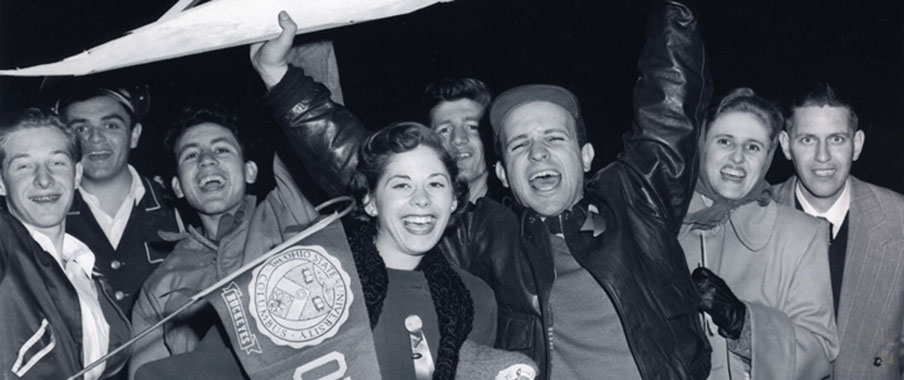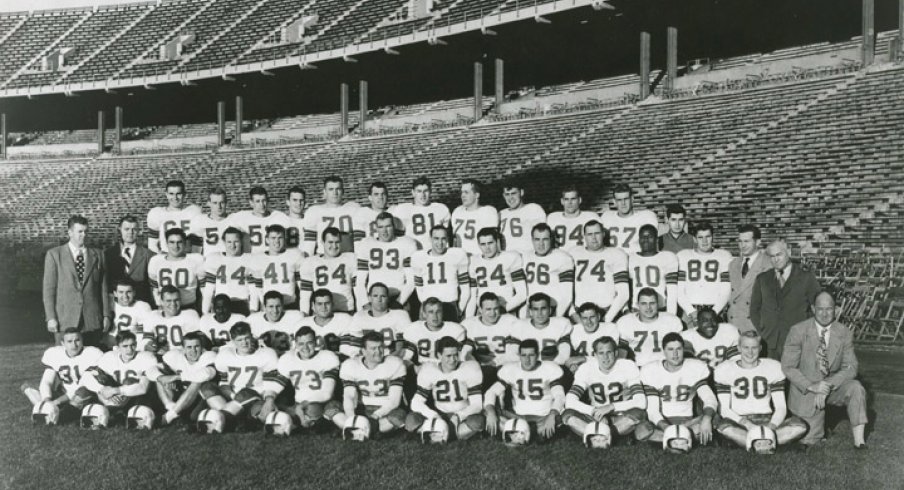Wes Fesler's second team showed improvement in 1948. With improvement comes expectations. Could the 1949 team rise to the challenge?
Fesler had 27 varsity players returning for the 60th football team in program history. Along with the experience, the Buckeyes had a strong sophomore class highlighted by Vic Janowicz.
Fesler's team had improved in 1948, his second season, but after a disastrous opening campaign, he needed to produce, especially against Michigan.
| The 1949 Buckeyes | |
|---|---|
| Record | 7–1–2 |
| B1G Record | 4–1–1, 1st |
| Coach | Wes Fesler (3rd year, 15–10–3) |
| Captain | Jack Wilson |
Games of Note
September 24th • Missouri • Ohio Stadium
The season opener was special on several levels. WLCW-C TV (now NBC4) televised the game, the first time an Ohio State game aired from Ohio Stadium.
This contest was also the last time Ohio State opened a season against Missouri. The Tigers served as the season opener for the Buckeyes the prior six years and eight of the last 11.
Don Faurot's club did not go down without a fight. Even with three first-half fumbles, Missouri went the half tied at 14 with the Buckeyes. Following intermission, the Tigers scored first and led 21-14, causing an uneasiness among the 66,510 in attendance.
Ohio State's Jerry Krall found Jimmy Hague for a 31-yard touchdown pass to tie the game once again.
Later in the third, Jack Lininger intercepted a Missouri pass to give the Buckeyes the ball at the Tigers' 30. A scoring strike shortly thereafter from Pandel Savic to Ray Hamilton finally gave Ohio State the lead.
Missouri countered early in the fourth and a touchdown but missed the all important extra point. The Buckeyes still led by one when Savic and Hamilton hooked up for a The 24-yard touchdown put Ohio State up for good.
Hamilton was a key factor in the Buckeyes' 35-34 victory. He had five carries for 111 yards and five receptions for 115 yards and two touchdowns.
Missouri ended the game with more plays and more yards than Ohio State, but failed to best Fesler's squad in the statistic that means the most.
| DATE | OPPONENT | LOCATION | RESULT |
|---|---|---|---|
| SEP. 24 | MISSOURI | OHIO STADIUM | W, 35–34 |
| OCT. 1 | INDIANA | OHIO STADIUM | W, 46–7 |
| OCT. 8 | # 8 USC | MEMORIAL COLISEUM | T, 13–13 |
| OCT. 15 | # 5 MINNESOTA | OHIO STADIUM | L, 0–27 |
| OCT. 22 | WISCONSIN | CAMP RANDALL | W, 21–0 |
| OCT. 29 | NORTHWESTERN | OHIO STADIUM | W, 24–7 |
| NOV. 5 | PITTSBURGH | PITT STADIUM | W, 14–10 |
| NOV. 12 | ILLINOIS | OHIO STADIUM | W, 30–17 |
| NOV. 19 | #5 MICHIGAN | MICHIGAN STADIUM | T, 7–7 |
| JAN. 2 | #3 CALIFORNIA | ROSE BOWL | W, 17–14 |
| 7–1–2, 207–136 |
October 8th • #8 USC • LA Memorial Coliseum
Like Missouri, the regular season series between USC and Ohio State was going on hiatus after the 1949 season.
The No. 11 Buckeyes entered the contest looking to improve on its 2–1 record against No. 8 USC in Los Angeles. Unfortunately, mistakes proved costly for Ohio State.
Ohio State fumbled seven times and two threw interceptions, fortunate to leave the west coast with a 13-13 tie. Both teams stewed over missing game-winning extra points after the game, but the Buckeyes had other opportunities to win.
From the Ohio State Football Media Guide:
The Buckeyes had their chances to win in the fourth. Ohio State missed a field goal try from the USC 18. On its next possession, The Buckeyes penetrated the USC 20-yard line, but were turned away on downs. Ohio State got the ball back one last time on its own 30, but the clock ran out after two plays.
The week prior to USC, Ohio State easily dispatched Indiana, 46-7. Vic Janowicz recorded his first touchdown and Ohio State outgained the Hoosiers 508-96 in total yards.
October 15th • #5 Minnesota • Ohio Stadium
In past years, Ohio State did not have success following road games against USC. That trend continued in 1949.
A powerful offensive line and running game drove Bernie Bierman's Minnesota team. Running backs Billy Bye and Dick Gregory benefited from the holes produced by two All-Americans on the Gophers' offensive line.
Center Clayton Tonnemaker and tackle Leo Nomellini cleared the way for Bye and Gregory to tally a combined 214 rushing yards. Minnesota won in Columbus for the first time since 1940, notching a 27-0 victory.
The Buckeyes did not have time to wallow in the loss. Next up was a trip to Madison followed by a home game against Northwestern. Ohio State shut out Wisconsin, 21-0 and defeated the Wildcats 24-7.
| OPPONENT | STREAK | RECORD |
|---|---|---|
| MISSOURI | W3 | 8–0–1 |
| INDIANA | W2 | 19–9–3 |
| USC | T1 | 4–3–1 |
| MINNESOTA | L1 | 5–4–1 |
| WISCONSIN | W2 | 11–6–2 |
| NORTHWESTERN | W1 | 17–9–1 |
| PITTSBURGH | W2 | 10–3–1 |
| ILLINOIS | W2 | 22–14–2 |
| MICHIGAN | T1 | 12–30–4 |
| CALIFORNIA | W1 | 1–1 |
November 5th • Pittsburgh • Pitt Stadium
Mike Milligan's Pittsburgh team sat at 5–1, the school's best start since 1938. With rivals Illinois and Michigan next on Ohio State's schedule, the Panthers were in perfect position to catch the Buckeyes in a trap game.
In the second quarter, Pittsburgh put the first points on the board when Earl Sumpter caught a 17-yard touchdown pass from Carl DePasqua. In the third, Nick Bolkavac kicked a 38-yard field goal, and Pittsburgh took a 10-0 lead.
It appeared Ohio State's second loss of the season was imminent until George Toneff recovered a Panther fumble at the Pittsburgh's 12-yard line. Savic cut the deficit to 10-7 after he snuck in from a yard out.
Ohio State then created another scoring opportunity when Billy Newell intercepted a Pittsburgh pass in Ohio State territory. Hamilton avoided four Pittsburgh defenders on a 22-yard scoring run to cap off the ensuing 70-yard drive.
The Buckeyes improved to 5–1–1 and was in the hunt for the Big Ten title after the 14-10 win.
November 12th • Illinois • Ohio Stadium
For the second straight game, Ohio State trailed 10-0. The Buckeyes had scoring chances in the first half, but failed to convert. Fesler inspired his team at halftime and it responded.
Savic threw a strike to Ralph Armstrong for the first score, then Janowicz put the Buckeyes on top 14-10 with one of his own. The Fighting Illini did not have an answer and Ohio State ran away with a 30-17 victory.
November 19th • #5 Michigan • Michigan Stadium
The No. 7 Buckeyes traveled north to Ann Arbor with the Rose Bowl on the line, needing only a win or tie to punch a ticket to Pasadena. Michigan needed a win for its third consecutive out-right Big Ten title.
Michigan drew first blood with a touchdown in the first quarter. Wally Teninga completed a 13-yard pass to Leo Koceski to give the Wolverines a 7-0 lead, the lone score through three quarters.
In the fourth, The Buckeyes called upon Savic, Hamilton and Morrison on the potential game-tying drive. Hamilton gashed Michigan with a 49-yard reception on a well-thrown ball by Savic.
From there Ohio State used Morrison as a battering ram to pound the ball into the end zone. He eventually scored from three yards out to cut the deficit to one.
Hague had not missed an extra point since the USC game. This was the wrong time to end his streak. Unfortunately, his kicked went wide right, but a Michigan player was offside and Hague received a second chance. He took advantage and tied the game at 7, the final score.
Ohio State was headed back to the Rose Bowl for the first time in 29 years.
January 2nd • #3 California • Rose Bowl
The first time these schools met, California blanked the Buckeyes 28-0 in the 1921 Rose Bowl. Former Northwestern coach Pappy Waldorf Golden led the Bears this time around.
No. 6 Ohio State found itself in a familiar position as Cal took an early 7-0 lead. Could the Buckeyes manufacture another come from behind victory?
Late in the game, Ohio State and Cal were knotted at 14. From the Ohio State Football Media Guide:
With just more than three minutes remaining in the game, Cal quarterback Bob Celeri was back to punt at his own 16 on fourth down. A low snap forced Celeri to kick the ball off his wrong (left) foot, the ball dribbling out of bounds at the Cal 13.
Three plays advanced Ohio State to the 6, where Jimmy Hague kicked the winning field goal with under two minutes remaining.
It was a dramatic end to a game OSU had dominated early, outgaining Cal 143-15 in total yards in the first half and driving inside the Bears' 20 three times with nothing to show for it. Two Ohio State touchdowns were called back by penalty.
The Buckeyes were the 1950 Rose Bowl champions.

1949 Recap
- Ohio State ended the opening game series with Missouri with an 8–0–1 advantage.
- The Buckeyes tied USC 13–13 in Los Angeles.
- Minnesota bullied Ohio State and defeated the Buckeyes in a shutout.
- OSU came from behind to defeat Pittsburgh, 14-10.
- The Buckeyes improved to 18–7 in the battle for the Illibuck.
- Ohio State dominated Illinois 34-7.
- The 7-7 tie in Ann Arbor gave the Buckeyes a share of the Big Ten title and a trip to the Rose Bowl.
- Ohio State defeated Cal 17-14 to win its first Rose Bowl.
- For the third straight season, nobody was named an All-American.
- Curly Morrison, Jack Jennings, Dick O'Hanlon, Jack Wilson, Bill Trautwein, Jim Hague and George Mattey were selected in the NFL Draft.
Fesler won the Big Ten and captured the Buckeyes first Rose Bowl victory. However, at the end of the 1949 season he wanted to resign.
Fesler felt he could never do enough to satisfy the fans. After a meeting with the athletic board in January of 1950, however, he decided to remain as Ohio State's head coach.



